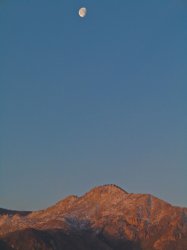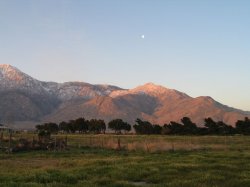Yes, I used afocal projection using an adapter that both holds the eyepiece and attaches to the front filter threads of the camera lens. This unit (eyepiece holder with attached camera) then slides inside the 2" drawtube of the telescope.
One reason I use this combination fairly often is that it affords the highest photographic magnification that I can use with my 2.8" Astro-Tech refracting telescope. I could go higher, but then vibration starts to become a bigger problem and in any case with a higher magnification the exposure times would start to get a little too long (i.e. with longer exposures you'd start to see motion in the moon or planets since I'm using an unguided tripod mount).
Also, I purchased a manual-focus, 24mm Nikon Ai lens (used on eBay) specifically for this task since on my APS-C sized camera sensor the 24mm lens offers the same angle of view (coverage) as the apparent field of my eyepiece. It's best to match these two factors since that will give you the "fastest," full-frame, non-vignetting image. When the 24mm lens is mated with a 10mm eyepiece on my telescope I get an effective 1032mm, f/14 telephoto result (24mm/10mm x 430mm -- the latter the prime focal length of the Astro-Tech telescope).
The Astro-Tech AT72ED telescope also deserves a nod here, given my few months of experience with this scope I'd have to say that it is an absolute bargain at only $400 (U.S.). That's just the price of the optical tube (with case). Eyepieces, star diagonal, mount, etc. are extras (which I already had).
As for the camera lens, it was manufactured in the early 1980s, has an all-metal construction, and is completely manual focus. Those latter two factors make it ideal for astrophotography. Frankly, the auto-focus, plastic-constructed lenses of today just don't "cut it" for most astrophotography needs.



















